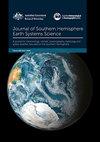澳大利亚新南威尔士州上亨特地区动态缩小尺度降雨数据的统计测试
IF 3.6
4区 地球科学
Q1 Earth and Planetary Sciences
引用次数: 0
摘要
本研究测试了缩小尺度气候数据的统计特性,重点关注用于供水水库模拟的水文预测所需的降雨。本研究使用的数据集由新南威尔士州(NSW) /澳大利亚首都地区(ACT)区域气候模拟(NARCliM)项目制作,该项目提供了澳大利亚东南部10公里分辨率的动态缩小的气候数据集。本文对美国国家环境预测中心(NCEP) /美国国家大气研究中心(NCAR)的缩小版NARCliM再分析模拟进行了评价。该验证已在澳大利亚新南威尔士州上亨特地区的古尔本河集水区进行。该分析将缩小的NARCliM降雨数据的时间序列与选定的气象局雨量站的地面测量数据和澳大利亚水资源利用项目(AWAP)的5公里网格数据进行了比较。降雨的初始测试侧重于自相关性,因为持续性是水文和水可用性分析中的一个重要因素。此外,对每日、每两周、每月和每年的平均时间分辨率进行交叉相关分析。在流域尺度上计算并绘制了这些统计数据的空间变异性。自相关分析表明,NARCliM数据的季节周期强于地面观测和AWAP数据的季节周期。互相关分析也显示NARCliM数据与AWAP和地面测量数据之间的一致性很差。空间变异性图显示了这些差异与流域尺度地形之间的可能联系。本文章由计算机程序翻译,如有差异,请以英文原文为准。
Statistical testing of dynamically downscaled rainfall data for the Upper Hunter region, New South Wales, Australia
This study tests the statistical properties of downscaled climate data, concentrating on the rainfall which is required for hydrology predictions used in water supply reservoir simulations. The datasets used in this study have been produced by the New South Wales (NSW) / Australian Capital Territory (ACT) Regional Climate Modelling (NARCliM) project which provides a dynamically downscaled climate dataset for southeast Australia at 10 km resolution. In this paper, we present an evaluation of the downscaled NARCliM National Centers for Environmental Prediction (NCEP) / National Center for Atmospheric Research (NCAR) reanalysis simulations. The validation has been performed in the Goulburn River catchment in the Upper Hunter region of New South Wales, Australia. The analysis compared time series of the downscaled NARCliM rain-fall data with ground based measurements for selected Bureau of Meteorology rainfall stations and 5 km gridded data from the Australian Water Availability Project (AWAP). The initial testing of the rainfall was focused on autocorrelations as persistence is an important factor in hydrological and water availability analysis. Additionally, a cross-correlation analysis was performed at daily, fort-nightly, monthly and annually averaged time resolutions. The spatial variability of these statistics were calculated and plotted at the catchment scale. The auto-correlation analysis shows that the seasonal cycle in the NARCliM data is stronger than the seasonal cycle present in the ground based measurements and AWAP data. The cross-correlation analysis also shows a poor agreement between NARCliM data, and AWAP and ground based measurements. The spatial variability plots show a possible link between these discrepancies and orography at the catchment scale.
求助全文
通过发布文献求助,成功后即可免费获取论文全文。
去求助
来源期刊

Journal of Southern Hemisphere Earth Systems Science
Earth and Planetary Sciences-Oceanography
CiteScore
8.10
自引率
8.30%
发文量
0
审稿时长
>12 weeks
期刊介绍:
The Journal of Southern Hemisphere Earth Systems Science (JSHESS) publishes broad areas of research with a distinct emphasis on the Southern Hemisphere. The scope of the Journal encompasses the study of the mean state, variability and change of the atmosphere, oceans, and land surface, including the cryosphere, from hemispheric to regional scales.
general circulation of the atmosphere and oceans,
climate change and variability ,
climate impacts,
climate modelling ,
past change in the climate system including palaeoclimate variability,
atmospheric dynamics,
synoptic meteorology,
mesoscale meteorology and severe weather,
tropical meteorology,
observation systems,
remote sensing of atmospheric, oceanic and land surface processes,
weather, climate and ocean prediction,
atmospheric and oceanic composition and chemistry,
physical oceanography,
air‐sea interactions,
coastal zone processes,
hydrology,
cryosphere‐atmosphere interactions,
land surface‐atmosphere interactions,
space weather, including impacts and mitigation on technology,
ionospheric, magnetospheric, auroral and space physics,
data assimilation applied to the above subject areas .
Authors are encouraged to contact the Editor for specific advice on whether the subject matter of a proposed submission is appropriate for the Journal of Southern Hemisphere Earth Systems Science.
 求助内容:
求助内容: 应助结果提醒方式:
应助结果提醒方式:


